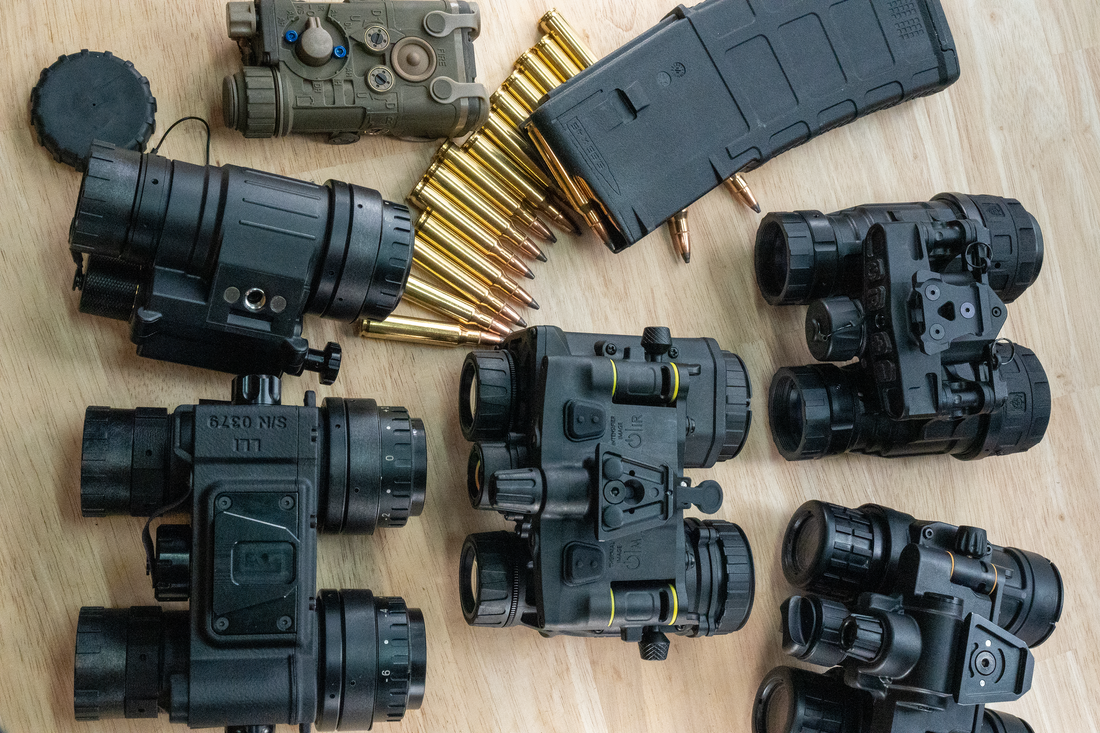
Night vision Monocular? Binocular? Panoramic?Fusion?
You're a newbie who has only ever seen through night vision goggles (NVGs) momentarily at a milsim or while out hunting with friends on private land. Ever since seeing firsthand the thousands of invisible stars present in the Milky Way or being able to navigate through nonsymmetrical terrain without reliance on visible white light, you have been intrigued with the concept of purchasing your own set of NVGs. However, before you can even consider putting down thousands of dollars of your hard-earned cash, you need to complete the daunting task of choosing what kind of housing you want, let alone what kind of image intensifier tube and glass should accompany said housing.
The purpose of this guide is to advise aspiring NVG owners and to give an introduction to the different types of housing that are available for the public to purchase. No housing is perfect. Each has its pros and cons and it will be up to the consumer to decide which will suit their mission requirement the best.
Monocular
A monocular is a device that allows you to observe with a single eye. It is one of the most popular choices due to its cost-effectiveness and abundance of parts available on the market. A significant advantage it offers for force-on-force training is that it enables your brain to merge images from both eyes, aiding in determining the color of light you are looking at. This helps prevent overshooting "dead" people with red light or mistaking targets who use infrared light as "dead" people. With another eye open, it also allows for smoother transitions into areas with dynamic lighting, making it a viable option for close-quarter combat.
Pro:
-Lower Cost
-situation awareness
-Lightweight
-Able to distinguish the color of light with another eye open.
One of the significant drawbacks of monoculars is the lack of depth perception. Our brains rely on having both eyes open to accurately judge the distances of objects in front of us. Consequently, it becomes more challenging to navigate stairs or uneven terrain with a monocular. There is also a learning curve involved; the initial 10-20 hours may be difficult for your brain to adjust. Additionally, some individuals may experience headaches with prolonged use.
Cons:
- Lack of depth perception
- Prolonged usage may lead to potential headaches
Fixed bridge Binocular
A Fixed Bridge Binocular is a night vision device (NVD) that enables observation with both eyes. The pods on the bridge are fixed and cannot be articulated (rotated) to the side, allowing for a simpler but more rugged design. This design choice is made to address a common weak point in articulated housings as the area between the pod which holds the image intensifier tube and the bridge is typically vulnerable. The majority of damaged binocular housings are a result of the articulation point breaking. Most fixed bridge models also have a lower cost than their articulated counterparts.
Another key advantage of fixed bridge binoculars and binoculars, in general, is increased depth perception and a slightly larger field of view due to the use of both eyes while operating the unit, making binoculars an ideal choice for navigating more nonlinear terrain.
Pros:
- Ruggedness
- Depth perception
- Lower cost
A fixed bridge increases ruggedness, but it comes with the limitation that the pods containing the tubes cannot be articulated to the side. To observe with normal vision, the night vision device (NVD) has to be stowed up with the mount. This may result in the overexertion of the muscles around the neck as they will need to compensate for the weight sitting outside of the center of gravity.
Cons:
- Less ergonomic than articulated Binoculars.

Articulated Binocular
An articulated binocular is a device that allows you to freely rotate the pods to the side, enabling you to use it as both a binocular and a monocular. In a stowed-up position, it reduces the leverage force exerted on your neck as the majority of the weight will be sitting closer to the center of gravity.
Pros:
- Able to use it like a monocular (Situation awareness & ability to distinguish type of light)
-Depth Perception (Covered in the fixed bridge section)
-Pods can be quickly rotated to the side
Cons:
- Costs more than a monocular & most fixed bridge binoculars

Panoramic night vision goggles
It is widely known as "Panos" and "quads". Panoramic night vision goggles are renowned for their extremely wide field of view (FOV) compared to their mono and bino housing counterparts. They feature the iconic quadruple pods, with two pods pointing outwards while the remaining two are parallel like a binocular. Each of these pods contains its own image intensifier tube, resulting in a total of four. Although there are 4 tubes, what you see is 3 circular images merged into a single image (see the photos below).
Pro:
-Situation awareness. Panoramic FOV, 90 to 120° compared to monocular and binocular, which typically have only 40-42° FOV.
-Depth perception
Con:
-Significantly higher price tag
-Heavier weight and more bulky

Fusion-Binoculars
The state-of-the-art in optical technology, this binocular seamlessly combines night vision and thermal imaging into one compact, rugged system—ideal for hunting, pest control, and professional field operations.
Now adopted as standard issue by the U.S. Marine Corps and under evaluation as a future standard for the New Zealand Defence Force, this fusion unit solves key limitations found in standalone systems. Night vision is often restricted by ambient light, while thermal can suffer from latency and makes navigation difficult. By merging both technologies, users get the best of both worlds—thermal detection overlaid with clear night vision imagery—enhancing target identification and situational awareness in all conditions.



There has never been a time in history where such a large selection of housings, let alone different variations of each type have been available to the public. This has surely complicated the process of deciding which housing to pair with each tube and glass. Please contact us if you are still unsure of which housing suits your needs best.
More info will be added at a later date.


